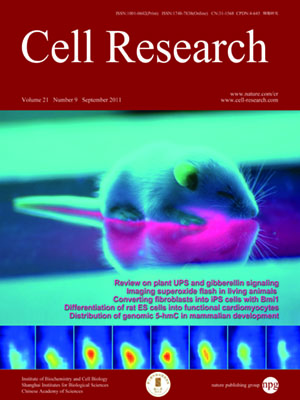
Volume 21, No 9, Sep 2011
ISSN: 1001-0602
EISSN: 1748-7838 2018
impact factor 17.848*
(Clarivate Analytics, 2019)
Volume 21 Issue 9, September 2011: 1316-1331
ORIGINAL ARTICLES
In vitro differentiation of rat embryonic stem cells into functional cardiomyocytes
Nan Cao1,*, Jing Liao2,*, Zumei Liu1, Wenmin Zhu1, Jia Wang1, Lijun Liu5, Lili Yu5, Ping Xu5, Chun Cui2, Lei Xiao2 and Huang-Tian Yang1,3,4
1Key Laboratory of Stem Cell Biology, Institute of Health Sciences, Shanghai Institutes for Biological Sciences (SIBS), Chinese Academy of Sciences (CAS) & Shanghai Jiao Tong University School of Medicine (SJTUSM), SIBS, CAS, Shanghai 200025, China;
2Laboratory of Molecular Cell Biology, Institute of Biochemistry and Cell Biology, Cell Bank, Stem Cell Bank, SIBS, CAS, Shanghai 200032, China;
3Shanghai Key Laboratory of Vascular Biology, Ruijin Hospital, SJTUSM, Shanghai 200025, China;
4Shanghai Stem Cell Institute, SJTUSM, Shanghai 200025, China;
5Shanghai Laboratory Animal Center (SLAC), CAS, Shanghai 200032, China
Correspondence: Huang-Tian Yang, Lei Xiao,(htyang@sibs.ac.cn; leixiao@sibs.ac.cn)
The recent breakthrough in the generation of rat embryonic stem cells (rESCs) opens the door to application of gene targeting to create models for the study of human diseases. In addition, the in vitro differentiation system from rESCs into derivatives of three germ layers will serve as a powerful tool and resource for the investigation of mammalian development, cell function, tissue repair, and drug discovery. However, these uses have been limited by the difficulty of in vitro differentiation. The aims of this study were to establish an in vitro differentiation system from rESCs and to investigate whether rESCs are capable of forming terminal-differentiated cardiomyocytes. Using newly established rESCs, we found that embryoid body (EB)-based method used in mouse ESC (mESC) differentiation failed to work for the serum-free cultivated rESCs. We then developed a protocol by combination of three chemical inhibitors and feeder-conditioned medium. Under this condition, rESCs formed EBs, propagated and differentiated into three embryonic germ layers. Moreover, rESC-formed EBs could differentiate into spontaneously beating cardiomyocytes after plating. Analyses of molecular, structural, and functional properties revealed that rESC-derived cardiomyocytes were similar to those derived from fetal rat hearts and mESCs. In conclusion, we successfully developed an in vitro differentiation system for rESCs through which functional myocytes were generated and displayed phenotypes of rat fetal cardiomyocytes. This unique cellular system will provide a new approach to study the early development and cardiac function, and serve as an important tool in pharmacological testing and cell therapy.
Cell Research (2011) 21:1316-1331. doi:10.1038/cr.2011.48; published online 22 March 2011
FULL TEXT | PDF
Browse 2450


